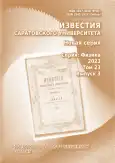IR spectra of hydrated CaSO4 in the mid-infrared range
- 作者: Morozov A.V.1, Olkhovatov D.V.1, Shapovalov V.L.1, Kochur A.G.1, Yavna V.A.1
-
隶属关系:
- Rostov State Transport University
- 期: 卷 23, 编号 3 (2023)
- 页面: 221-237
- 栏目: Articles
- URL: https://ogarev-online.ru/1817-3020/article/view/251539
- DOI: https://doi.org/10.18500/1817-3020-2023-23-3-221-237
- EDN: https://elibrary.ru/DTJJSN
- ID: 251539
如何引用文章
全文:
详细
作者简介
Andrey Morozov
Rostov State Transport University2 Rostovskogo Strelkovogo Polka Narodnogo Opolcheniya Sq., Rostov-on-Don 344038, Russia
Dmitry Olkhovatov
Rostov State Transport University2 Rostovskogo Strelkovogo Polka Narodnogo Opolcheniya Sq., Rostov-on-Don 344038, Russia
Vladimir Shapovalov
Rostov State Transport University
ORCID iD: 0000-0001-5791-0337
2 Rostovskogo Strelkovogo Polka Narodnogo Opolcheniya Sq., Rostov-on-Don 344038, Russia
Andrei Kochur
Rostov State Transport University2 Rostovskogo Strelkovogo Polka Narodnogo Opolcheniya Sq., Rostov-on-Don 344038, Russia
Victor Yavna
Rostov State Transport University2 Rostovskogo Strelkovogo Polka Narodnogo Opolcheniya Sq., Rostov-on-Don 344038, Russia
参考
- Pegau W. S., Gray D., Zaneveld J. R. V. Absorption and attenuation of visible and near-infrared light in water: Dependence on temperature and salinity. Applied Optics, 1997, vol. 36, iss. 24, pp. 6035–6046. https://doi.org/10.1364/AO.36.006035
- Max J.-J., Gessinger V., van Driessche C., Larouche P., Chapados C. Infrared spectroscopy of aqueous ionic salt solutions at low concentrations. J. Chem. Phys., 2007, vol. 126, iss. 18, article no. 184507. https://doi.org/10.1063/1.2717184
- Cheng-Wen Liu, Feng Wang, Lijiang Yang, Xin-Zheng Li, Wei-Jun Zheng, Yi Qin Gao. Stable salt-water cluster structures reflect the delicate competition between ion-water and water-water interactions. J. Phys. Chem. B, 2014, vol. 118, iss. 3, pp. 743–751. https://doi.org/10.1021/jp408439j
- Tandy J. D., Feng C., Boatwright A., Sarma G., Sadoon A. M., Shirley A., Rodrigues N. D., Cunningham E. M., Yang S., Ellis A. M. Communication: Infrared spectroscopy of salt-water complexes. J. Chem. Phys., 2016, vol. 144, article no. 121103. https://doi.org/10.1063/1.4945342
- Mizoguchi A., Ohshima Y., Endo Y. Microscopic hydration of the sodium chloride ion pair. J. Am. Chem. Soc., 2003, vol. 125, iss. 7, pp. 1716–1717. https://doi.org/10.1021/ja028522x
- Christian P. P., Mark S. G. Solvation of sodium chloride: An effective fragment study of NaCl(H2O)n. J. Phys. Chem. A, 1999, vol. 103, pp. 4162–4166. https://doi.org/10.1021/jp984806l
- Olleta A. C., Lee H. M., Kim K. S. Ab initio study of hydrated sodium halides NaX(H2O)(1–6) (X=F, Cl, Br, and I). J. Chem. Phys., 2006, vol. 124, iss. 2, article no. 024321. https://doi.org/10.1063/1.2147283
- Hou G. L., Liu C. W., Li R. Z., Xu H. G., Gao Y. Q., Zheng W. J. Emergence of solvent-separated Na+–Cl− ion pair in salt water: Photoelectron spectroscopy and theoretical calculations. J. Phys. Chem. Lett., 2017, vol. 8, iss. 1, pp. 13–20. https://doi.org/10.1021/acs.jpclett.6b02670
- Wei Z. Y., Yang L. J., Gong S. Y., Xu H. G., Xu X. L., Gao Y. Q., Zheng W. J. Comparison of the microsolvation of CaX2 (X = F, Cl, Br, I) in water: Size-selected anion photoelectron spectroscopy and theoretical calculations. J. Phys. Chem. A., 2021, vol. 125, iss. 16, pp. 3288–3306. https://doi.org/10.1021/acs.jpca.1c00573
- Granovsky A. A. Firefly version 8. Available at: http://classic.chem.msu.su/gran/firefly/index.html (accessed October 3, 2022).
- Schmidt M. W., Baldridge K. K., Boatz J. A., Elbert S. T., Gordon M. S., Jensen J. H., Koseki S., Matsunaga N., Nguyen K. A., Su S., Windus T. L., Dupuis M., Montgomery J. A. General atomic and molecular electronic structure system. J. Comput. Chem., 1993, vol. 14, no. 11, pp. 1347–1363. https://doi.org/10.1002/jcc.540141112
- Bode B. M., Gordon M. S. MacMolPlt: A graphical user interface for GAMESS. J. Mol. Graph. Model., 1998, vol. 16, iss. 3, pp. 133–138. https://doi.org/10.1016/s1093-3263(99)00002-9
- Morozov A., Nazdracheva T., Kochur A., Yavna V. Manifestation of hydration of Na+ and Cl- ions in the IR spectra of NaCl aqueous solutions in the range of 2750–4000 cm−1 . Spectrochim. Acta A Mol. Biomol. Spectrosc., 2023, vol. 287 (Pt. 2), article no. 122119. https://doi.org/10.1016/j.saa.2022.122119
- Downs R. T., Hall-Wallace M. The American mineralogist crystal structure database. American Mineralogist, 2003, vol. 88, pp. 247–250.
- Darling B. T., Dennison D. M. The Water vapor molecule. Phys. Rev., 1940, vol. 57, pp. 128–139.
- Benedict W. S., Gailar N., Plyler E. K. Rotation-vibration spectra of deuterated water vapor. J. Chem. Phys., 1956, vol. 24, pp. 1139–1165. https://doi.org/10.1063/1.1742731
- Morozov A., Nazdracheva T., Kochur A., Yavna V. Effect of sodium chloride on the profiles of the IR spectrum bands of kaolinite at moistures under plastic limit. Crystals, 2022, vol. 12, iss. 9, article no. 1224. https://doi.org/10.3390/cryst12091224
- Brubach J. B., Mermet A., Filabozzi A., Gerschel A., Roy P. Signatures of the hydrogen bonding in the infrared bands of water. J. Chem. Phys., 2005, vol. 122, article no. 184509. https://doi.org/10.1063/1.1894929
补充文件









